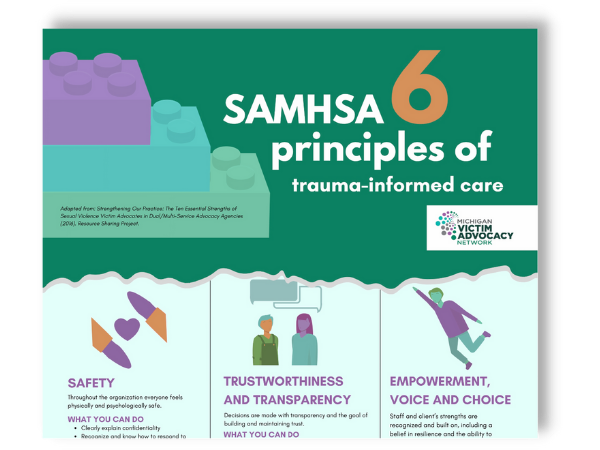SAMHSA 6 Principles of Trauma-Informed Care
Safety: Throughout the organization everyone feels physically and psychologically safe.
What you can do:
- Clearly explain confidentiality
- Recognize and know how to respond to signs of trauma responses
- Meet in physically secure and accessible locations
Trustworthiness and Transparency: Clarify and maintain appropriate boundaries Explain the reasons behind policies, procedures, and approaches
What you can do:
- Maintain privacy and confidentiality
- Explain defined advocacy role
- Decisions are made with transparency and the goal of building and maintaining trust
Empowerment, Voice and Choice: Communicate adaptive trauma responses and validate resilience and the ability to heal from trauma
What you can do:
- Communicate adaptive trauma response and validate resilience
- Allow victims and survivors to provide feedback on the services they receive
- Highlight strengths
Offer choices in meeting environment (e.g. door locked or unlocked, where to sit)
Cultural Humility and Responsiveness: The impacts of biases, stereotypes, systemic oppression, and historical trauma are recognized and addressed.
What you can do:
- Respect names and pronouns Recognize the impact of historical and cultural trauma
- Make appropriate referrals to culturally specific organizations within the community
- Actively engage in cultural and community honoring practices
Collaboration: Power differences between and among staff and clients are leveled by supporting shared decision-making.
What you can do:
- Share power in decision-making
- Acknowledge that victims and survivors are the experts in their own lives
- Avoid leading discussions about trauma like a teacher and involve victims/survivors in the learning process
Peer Support: Individuals with shared experiences, who volunteer to do so, are integrated into the organization and viewed as integral to service delivery.
What you can do: Offer victims and survivors opportunities to be with other victims and survivors and offer mutual support
Adapted from: Strengthening Our Practice: The Ten Essential Strengths of Sexual Violence Victim Advocates in Dual/Multi-Service Advocacy Agencies (2016). Resource Sharing Project.
SAMHSA’ Concept of Trauma and Guidance for a Trauma-Informed Approach (2014). Substance Abuse and Mental Health Services Administration.
Mivan.org/resources



